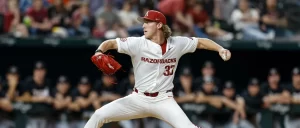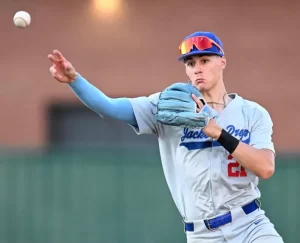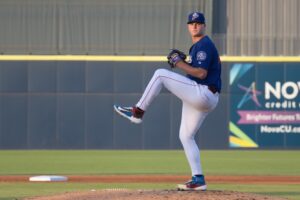2018 Draft Preview: 2B Nick Madrigal
Nick Madrigal
School: Oregon St. (Junior)
Position: Second Baseman
Height/Weight: 5-7, 160 lbs
B/T: R/R
D.O.B: 3/15/1997
Previously Drafted: 2015, 17th (514 overall) – Cleveland
2018 statline: .435/.467/.580 (1.047 OPS), 2 2B, 1 3B, 2 HR, 15 RBI, 3 SB, 4 BB, 2 K, 75 PA (per Baseball Cube)
Scouting Reports:
“Analytics departments love him because of his approach at the plate that led to more walks than strikeouts in 2017, and while he doesn’t have a ton of over-the-fence power, he makes consistent hard contact and is a legitimate extra-base threat. His speed and instincts should allow him to continue to be a base stealer.
…some feel he could handle shortstop if need be. If not, he has the chance to be a Gold Glove caliber second baseman in the future. Even with the injury, he should land squarely in the top 10 in June.” – MLB Pipeline
“A potential top-of-the-order hitter, Madrigal also projects as a plus defensive second baseman at the next level. The hands that allow him to hit with such apparent ease also translate to the field, where he is sure-handed and quick around the bag with enough arm strength for the keystone. Arm strength is the one knock on Madrigal—aside from his size—and scouts are split on whether he can be a major league shortstop… Regardless of which side of the bag teams see him playing in the future, Madrigal seems like a lock to be taken inside of the first ten picks this June and could be a fast-moving college bat at the professional level, thanks to both his baseball skills and professional makeup and work ethic.” – Baseball America ($$)
Scouting Grades (Via MLB Pipeline):
Hit: 65
Power: 40
Run: 60
Arm: 50
Field: 55
Overall: 55
Prospect Overview and Future Outlook:
Can it really be a draft if there isn’t at least one polarizing prospect among the field? That designation falls to Oregon St. second baseman Nick Madrigal in 2018, who represents a Grand Canyon level divide among the scouting community. Pair Madrigal’s elite performance with a projectable 6’3″ specimen and he might not even make it to the White Sox at four.
But there’s no such thing as a perfect prospect and the art is in quantifying the tangible and intangible pros and cons of each profile, in which Madrigal’s de facto con is his minute stature. At 5’7″, 160 pounds, Madrigal is shorter than last year’s small bodied Nick Allen, who was dogged for similar reasons, and fell to #81 overall to the Oakland Athletics.
Madrigal’s physical ceiling may not crack six feet but his draft ceiling will certainly crack the top ten and it’s all buoyed by a plus hit tool that has the analytical divisions of MLB front offices going to bat for the Oregon St. infielder.
Drafted as a 17th rounder out of high school, Madrigal wisely chose college over pro ball and has since seen his draft stock skyrocket as a Beaver. He improved upon an .836 OPS his freshman season, for which he won PAC-12 freshman of the year, with a .380/.449/.532 slash line in his second act. His junior year, arguably the most pivotal season for a budding college prospect, started with more of a break than a break-out as Madrigal broke his wrist sliding into home plate just six games into the season.
They were a good six games though and he’s continued to rake since his recent return to the keystone. His .435/.467/.580 slash is quite impressive, albeit in only 16 games. But getting back on the field has only reinforced what the scouting community already knew, which is that the hit tool might be the best of this entire draft class.
Madrigal incorporates a high leg kick into his hitting motion, which gives him the forward momentum necessary to generate some of the gap power he’s shown in the past. His build appears to lack significant muscle, so not only does this work from a timing perspective, but it’s a Dustin Pedroia minded approach to maximizing barrel impact.
That said, he does turn and plant rather quickly, which goes to show that his hitting mechanics are geared more toward contact and timing rather than power, so what you’re buying here is really the plate coverage and bat-to-ball skills than any sort of untapped power potential.
But in the former respect, Madrigal is as close as you can get to a sure bet to make contact. He’s struck out just 5.3 percent of the time across 566 PAs at Oregon St. From a batting eye perspective, he’s actually only walked 8.3 percent of the time, so even his high OBP ultimately boils down to the hit tool. He’s had more walks than strikeouts in all three of his collegiate seasons, and has just two punch-outs 16 games in 2018.
Of course, the ultimate trade off with a slap-hitter style approach is a power outage. Madrigal maintains high BABIPs because of his plus speed, and that also boosts his XBH%, but the lack of leverage behind his swing means home run pop has been minimal (Just 7 bombs in his college career).
With this profile, Madrigal has to bring a lot more to the table to be a premium pick than just bat-to-ball skills and that’s where the run and field tools give him some help. He grades out as a 60+ runner, with efficacy in the stolen base department – peaking at 16 swipes in 2017 and never falling below an 80% success rate. This is where the on-base skills are complemented the most and what makes Madrigal a prototypical table setter.
The defense at second base is what wraps up an already strong profile with an even nicer bow. Madrigal probably has the chops to be passable at shortstop, and was only moved off the position to accommodate his teammate Cadyn Grenier, and as a result he plays up at second. The ceiling here is that of a potentially gold glove defender at second.
The fact that Madrigal might have the best bat control in this class and pairs that with very playable foot speed and defense, means whoever takes the Oregon St. infielder is cashing in on a low-risk selection. Madrigal is sure to be a major leaguer in some capacity, but as attractive as it is to look at more power potent comps in Jose Altuve or even Ozzie Albies, over-the-fence pop is just not Madrigal’s game.
10-15 home runs a season is more of a ceiling rather than a lock, whereas it’s much more likely that the average ticks above .300 while the slugging battles to stay above .400. But the polish is so strong here that drawing the short stick on one tool isn’t enough to zap an otherwise prolific profile.
Draft Day:
The wrist injury hasn’t done anything to dampen the Madrigal hype. If anything, his ability to bounce back and already be a plug-and-play option for the Beavers is a testament to his work ethic and make-up, each of which consistently get high marks.
Baseball America rates him as the 3rd best prospect in their Draft 500 while MLB Pipeline concurs. ESPN’s Keith Law has him inside the top ten at number six.
Madrigal’s low-risk and endearment to analytically minded teams will make him a popular pick on draft day. It’s entirely possible that he’s not even there for Chicago at the fourth overall selection.
Keith Law has the White Sox passing on him in favor of another college bat in C Joey Bart and Madrigal going the pick after to Cincinnati in his latest mock. MLB Pipeline has Madrigal already off the board and donning a Phillies cap in their most recent mock draft but says he’d be in play if he fell.
Baseball America has Chicago passing on Madrigal in favor of 3B Jonathan India of the SEC, who they feel has faced stronger competition than Madrigal – who they have pegged going to the Mets at six.
One calling card for Madrigal is his quick-to-the-majors path, as his relative polish does expedite his track to the bigs. There’s been conjecture that Chicago may not like Madrigal due to their incumbents up the middle in Tim Anderson and Yoan Moncada. While it’s valid to say Chicago is fairly set in that regard, it won’t move the needle one iota on draft day.
If the White Sox feel Madrigal is the best player available when they’re on the clock, they will pick him regardless of his bearing on the current roster landscape. Ultimately draft picks are assets, If a player doesn’t have a role in Chicago, they can be shuffled for another area of need and there’s no reason to dilute the talent portfolio simply because of a poor existing roster fit. It’s possible whoever Chicago takes on draft day could serve as a future trade chip as a means to an end in augmenting a potential contender.
That said, if Chicago doesn’t buy that Madigral can hit for 10-15 HR power and reins in his ceiling for it, college bats like Joey Bart or Alec Bohm will likely look more attractive. This is to say nothing of a bevy of intriguing arms or the potential that they try to go under-slot with an athletic prep bat.
But if the overall goal is to hedge risk at #4 and go hard on more volatile, higher ceiling targets in the later rounds, then Madrigal isn’t necessarily a bad play.
Cage work per Baseball America
Cage work and plate appearance with 2017 USA Baseball Collegiate National Team per 2080 Baseball
Want to know right away when we publish a new article? Type your email address in the box on the right-side bar (or at the bottom, if on a mobile device) and click the “create subscription” button. Our list is completely spam free, and you can opt out at any time.






